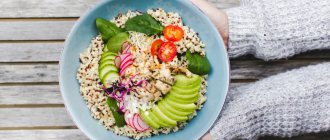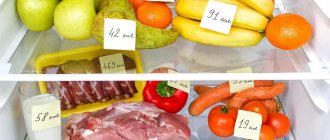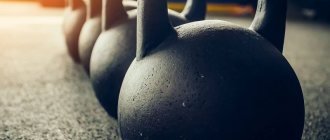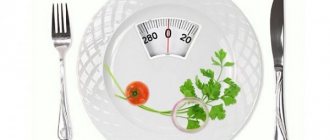People who want to lose weight first need to find out how many calories are in 1 kg of fat. If you have such knowledge, you can competently build a weight loss program, achieving greater efficiency. In addition, a person interested in his health needs to pay attention to the features of losing excess weight by following a diet and doing physical exercise.
Fat and the human body: why is it important to know how many calories are in a kilogram of fat?
Fat deposits in the body provide protection to human internal organs from mechanical stress and support the functioning of the body in the absence of sufficient amounts of food for a long time. They also help to recover from illness.
However, the amount of fat needs to be controlled. Otherwise, if the norm is exceeded, it will have a detrimental effect on vital processes:
- hormonal imbalance;
- With increased volumes of fat, internal organs work for wear and tear;
- load on joints, blood vessels;
- In addition, it is also worth noting the risks of serious diseases.
Therefore, it is so important to monitor the current indicators of body fat; in this regard, you should study how many calories are in 1 kg of human fat and how to properly get rid of excess volumes.
Properties of human fat
Fashion magazines, popular books, and in schools often frighten us with the incorrect statement that excess weight is associated with genetics, such as skin and eye color. There is an opinion that the baby's weight depends on the mother's nutrition. It is believed that in obesity, fat cells are capable of dividing on their own, which only a surgeon can handle.
In fact, everything is much simpler: people have two types of fat: subcutaneous and visceral. We can easily see the subcutaneous tissue in the mirror - these are our folds, cellulite. And the visceral is located on our internal organs. And if there is a lot of fat, it aggravates their work and leads to hormonal disruptions.
Together with blood, fat cells spread through the vessels, clogging them and settling on the walls. The supply of blood and oxygen to the cells is hampered, creating high blood pressure, shortness of breath and malaise. Visceral or internal excess fat leads to the appearance of nasty cholesterol plaques. With a large number of them, the likelihood of stroke and heart attack increases.
On a diet and proper nutrition, subcutaneous fat is lost first. Sports are also good for this, but abdominal exercises and squats will not reach the heart. To remove visceral fat, you need to firmly address your eating habits.
How many calories are in 1 kg of fat?
First of all, it is worth clarifying the composition of human fat:
- lipids in a volume from 54% to 85% of the total mass;
- water;
- proteins;
- enzymes.
As for how many calories are in 1 gram of fat in its pure form, it contains about 9 kilocalories. 1 kg of fat will contain approximately 7.7 kcal. However, deposits in their pure form are not found in the human body, so the number of calories will be lower. The exact value depends on the specific composition of fat, which is determined taking into account the characteristics of the individual organism. The average calorie intake is 6.5 kcal.
The 500-calorie deficit: fact or fiction?
Vishnofsky made some mistakes in his research and conclusions. He suggested that when losing weight, a person loses only adipose tissue
Likewise, did not take into account how the body would react to weight loss
According to Kevin Hall, a researcher at the National Institute of Diabetes and Digestive and Kidney Diseases, when you first start cutting back on your daily caloric intake, the number of calories your body burns also decreases.
For example, if you reduce your caloric intake by 500 kcal per day, you will notice weight loss. However, over time, the body adapts to weight loss and a calorie deficit. Your metabolic rate will decrease and you will need to continue to reduce calories to maintain the rate of initial weight loss. This goes against the 3,500 calorie per pound rule and breaks the myth of the 500 calorie deficit. It overestimates the amount of weight that can be lost in a given period of time.
As you progress, you have to increase your calorie deficit to be more effective. A gradual slowdown in body weight loss requires adjustments.
How many calories will you need to burn to lose a pound of fat?
Having decided how many calories are in a person’s fat, and having identified its excess in your body, you should proceed to the procedure for achieving the norm. Having knowledge about the natural processes of the body will allow you to lose weight with greater productivity.
To lose weight, you need to be in a calorie deficit. You will need to make sure that the volume burned is less than what a person receives from the daily diet. If you want to lose a pound of fat, you will need to achieve a deficit of 7 thousand calories. Therefore, to lose weight to a given value in a week, you need to create a deficit of 1 thousand calories per day.
For example, if your daily menu consists of 2.9 kcal, you need to remove foods from your diet to achieve 1.9 kcal.
Table of calories, fats, proteins, carbohydrates and food products per 100 grams
Calories into the body supply energy substances not only for sports; 1 g of fat supplies 9 kcal, 1 g of protein and 1 g of carbohydrates are much less (4 kcal each). If you need to select the most high-calorie foods for feeding a person of a certain category, it is necessary to take into account the standard balance of the components of these products. For example, for a man aged 30 years old, working in production with working conditions that do not require excessive physical stress, because labor-intensive processes are mechanized, and living in a large city with developed public services requires 3000 kcal per day. In this case, the following balance must be maintained: animal proteins 54 g, vegetable proteins 45 g, animal fats 68 g, vegetable fats 29 g, carbohydrates 413 g.
A person needs vitamins daily: A - 1.5 mg, 3 mg of thiamine, 2.5 mg of riboflavin, 10 mg of pantothenic acid, 2 mg of pyridoxine, 0.2 mg of folic acid in mass, C - 70 mg, P - 35 mg, 15 mg of nicotinic acid, E - 20 mg, K - 1 mg, 0.15 mg of biotin. The human body must receive macroelements daily: 3 g of potassium. 8 g sodium chloride, 0.8 g calcium, 0.5 g magnesium, 1.5 g phosphorus, 15 mg iron. In addition, the body needs trace elements in certain quantities (copper, manganese, aluminum, molybdenum, bromine, iodine, cobalt, silicon, beryllium, zinc, fluorine), enzymes, hormones, essential amino acids. An excess or deficiency of each of these components causes certain harm to the body. It is extremely difficult to select a combination of products containing a strict balance of all components of a balanced diet.
From flour to baked goods
| Water | Squirrels | Fats | Carbohydrates | kcal | |
| Rye bread | 42,4 | 4,7 | 0,7 | 49,8 | 214 |
| Millet bread. from grade I flour | 34,3 | 7,7 | 2,4 | 53,4 | 254 |
| Butter pastries | 26,1 | 7,6 | 4,5 | 60 | 297 |
| Baranki | 17 | 10,4 | 1,3 | 68,7 | 312 |
| Drying | 12 | 11 | 1,3 | 73 | 330 |
| Wheat crackers | 12 | 11,2 | 1,4 | 72,4 | 331 |
| Cream crackers | 8 | 8,5 | 10,6 | 71,3 | 397 |
| Wheat flour varieties | 14 | 10,3 | 0,9 | 74,2 | 327 |
| Wheat flour, grade I | 14 | 10,6 | 1,3 | 73,2 | 329 |
| Wheat flour, grade II | 14 | 11,7 | 1,8 | 70,8 | 328 |
| Rye flour | 14 | 16,9 | 1,1 | 76,9 | 326 |
Milk, cheeses and other dairy products
| Water | Squirrels | Fats | Carbohydrates | kcal | |
| Cow's milk cheese | 52,0 | 17,9 | 20,1 | 0,0 | 260 |
| Natural yoghurt 1.5% fat | 88,0 | 5,0 | 1,5 | 3,5 | 51 |
| Full fat kefir | 88,3 | 2,8 | 3,2 | 4,1 | 59 |
| Low-fat kefir | 91,4 | 3,0 | 0,1 | 3,8 | 30 |
| Acidophilus milk | 81,7 | 2,8 | 3,2 | 10,8 | 83 |
| Whole milk powder | 4,0 | 25,6 | 25,0 | 39,4 | 475 |
| Condensed milk | 74,1 | 7,0 | 7,9 | 9,5 | 135 |
| Condensed milk with sugar | 26,5 | 7,2 | 8,5 | 56,0 | 315 |
| Curdled milk, cheese milk | 88,4 | 2,8 | 3,2 | 4,1 | 58 |
| Ryazhenka | 85,3 | 3,0 | 6,0 | 4,1 | 85 |
| Cream 10% | 82,2 | 3,0 | 10,0 | 4,0 | 118 |
| Cream 20% | 72,9 | 2,8 | 20,0 | 3,6 | 215 |
| Sour cream 10% | 82,7 | 3,0 | 10,0 | 2,9 | 116 |
| Sour cream 20% | 72,7 | 2,8 | 20,0 | 3,2 | 206 |
| Cheeses and a lot of curds. special | 41,0 | 7,1 | 23,0 | 27,5 | 340 |
| Russian cheese | 40,0 | 23,4 | 30,0 | 0,0 | 371 |
| Dutch cheese | 38,8 | 26,8 | 27,3 | 0,0 | 361 |
| Swiss cheese | 36,4 | 24,9 | 31,8 | 0,0 | 396 |
| Poshekhonsky cheese | 41,0 | 26,0 | 26,5 | 0,0 | 334 |
| Processed cheese | 55,0 | 24,0 | 13,5 | 0,0 | 226 |
| Fat cottage cheese | 64,7 | 14,0 | 18,0 | 1,3 | 226 |
| Cottage cheese semi-fat | 71,0 | 16,7 | 9,0 | 1,3 | 156 |
| Low-fat cottage cheese | 77,7 | 18,0 | 0,6 | 1,5 | 86 |
Cereals
| Water | Squirrels | Fats | Carbohydrates | kcal | |
| Hercules | 12 | 13,1 | 16,2 | 65,7 | 355 |
| Buckwheat core | 14 | 12,6 | 2,6 | 68,0 | 329 |
| Buckwheat done | 14 | 9,5 | 1,9 | 72,2 | 326 |
| Corn | 14 | 8,3 | 1,2 | 75,0 | 325 |
| Manna | 14 | 11,3 | 0,7 | 73,3 | 326 |
| Oatmeal | 12 | 11,9 | 5,8 | 65,4 | 345 |
| Pearl barley | 14 | 9,3 | 1,1 | 73,7 | 324 |
| Millet | 14 | 12 | 2,9 | 69,3 | 334 |
| Rice | 14 | 7 | 0,6 | 73,7 | 323 |
| Wheat “Poltavskaya” | 14 | 12,7 | 1,1 | 706 | 325 |
| Oatmeal | 10 | 12,2 | 5,8 | 68,3 | 357 |
| Barley | 14 | 10,4 | 1,3 | 71,7 | 322 |
Fats, margarine and oils
| Water | Squirrels | Fats | Carbohydrates | kcal | |
| Rendered fat | 0,3 | 0 | 99,7 | 0 | 897 |
| Milk margarine | 15,9 | 0,3 | 82,3 | 1 | 746 |
| Sandwich margarine | 15,8 | 0,5 | 82 | 1,2 | 744 |
| Mayonnaise | 25 | 3,1 | 67 | 2,6 | 627 |
| Vegetable oil | 0,1 | 0 | 99,9 | 0 | 899 |
| Butter | 15,8 | 0,6 | 82,5 | 0,9 | 748 |
| Ghee | 1 | 0,3 | 98 | 0,6 | 887 |
| Pork bacon (without skin) | 5,7 | 1,4 | 92,8 | 0 | 816 |
Vegetables
| Water | Squirrels | Fats | Carbohydrates | kcal | |
| Eggplant | 91 | 0,6 | 0,1 | 5,5 | 24 |
| Swede | 87,5 | 1,2 | 0,1 | 8,1 | 37 |
| Green peas | 80 | 5,0 | 0,2 | 13,3 | 72 |
| Zucchini | 90,3 | 0,6 | 0,3 | 5,7 | 27 |
| White cabbage | 90 | 1,8 | — | 5,4 | 28 |
| Red cabbage | 90 | 1,8 | — | 6,1 | 31 |
| Cauliflower | 90,9 | 2,5 | — | 4,9 | 29 |
| Potato | 76 | 2 | 0,1 | 19,7 | 83 |
| Green onion (feather) | 92,5 | 1,3 | — | 4,3 | 22 |
| Leek | 87 | 3 | — | 7,3 | 40 |
| Bulb onions | 86 | 1,7 | — | 9,5 | 43 |
| Red carrots | 88,5 | 1,3 | 0,1 | 7 | 33 |
| Ground cucumbers | 95 | 0,8 | — | 3 | 15 |
| Greenhouse cucumbers | 96,5 | 0,7 | — | 1,8 | 10 |
| Sweet green pepper | 92 | 1,3 | — | 4,7 | 23 |
| Sweet red pepper | 91 | 1,3 | — | 5,7 | 27 |
| Parsley (greens) | 85 | 3,7 | — | 8,1 | 45 |
| Parsley (root) | 85 | 1,5 | — | 11 | 47 |
| Rhubarb (petiole) | 94,5 | 0,7 | — | 2,9 | 16 |
| Radish | 93 | 1,2 | — | 4,1 | 20 |
| Radish | 88,6 | 1,9 | — | 7 | 34 |
| Turnip | 90,5 | 1,5 | — | 5,9 | 2,8 |
| Salad | 95 | 1,5 | — | 2,2 | 14 |
| Beet | 86,5 | 1,7 | — | 10,8 | 48 |
| Tomatoes (ground) | 93,5 | 0,6 | — | 4,2 | 19 |
| Tomatoes (greenhouse) | 94,6 | 0,6 | — | 2,9 | 14 |
| Green beans | 90 | 4 | — | 4,3 | 32 |
| Horseradish | 77 | 2,5 | — | 16,3 | 71 |
| Cheremsha | 89 | 2,4 | — | 6,5 | 34 |
| Garlic | 70 | 6,5 | — | 21,2 | 106 |
| Spinach | 91,2 | 2,9 | — | 2,3 | 21 |
| Sorrel | 90 | 1,5 | — | 5,3 | 28 |
Fruits and berries
| Water | Squirrels | Fats | Carbohydrates | kcal |
| Apricots | 86 | 0,9 | 10,5 | 46 |
| Quince | 87,5 | 0,6 | 8,9 | 38 |
| Cherry plum | 89 | 0,2 | 7,4 | 34 |
| A pineapple | 86 | 0,4 | 11,8 | 48 |
| Orange | 87,5 | 0,9 | 8,4 | 38 |
| Bananas | 74 | 1,5 | 22,4 | 91 |
| Cowberry | 87 | 0,7 | 8,6 | 40 |
| Grape | 80,2 | 0,4 | 17,5 | 69 |
| Cherry | 85,5 | 0,8 | 11,3 | 49 |
| Blueberry | 88,2 | 1 | 7,7 | 37 |
| Pomegranate | 85 | 0,9 | 11,8 | 52 |
| Grapefruit | 89 | 0,9 | 73 | 35 |
| Pear | 87,5 | 0,4 | 10,7 | 42 |
| Blackberry | 88 | 2 | 5,3 | 33 |
| Strawberries | 84,5 | 1,8 | 8,1 | 41 |
| Figs | 83 | 0,7 | 13,9 | 56 |
| Dogwood | 85 | 1 | 9,7 | 45 |
| Cranberry | 89,5 | 0,5 | 4,8 | 28 |
| Gooseberry | 85 | 0,7 | 9,9 | 44 |
| Lemon | 87,7 | 0,9 | 3,6 | 31 |
| Raspberries | 87 | 0,8 | 9 | 41 |
| Mandarin | 88,5 | 0,8 | 8,6 | 38 |
| Cloudberry | 83,3 | 0,8 | 6,8 | 31 |
| Sea buckthorn | 75 | 0,9 | 5,5 | 30 |
| Peaches | 86,5 | 0,9 | 10,4 | 44 |
| Rowan garden | 81 | 1,4 | 12,5 | 58 |
| Rowan chokeberry | 80,5 | 1,5 | 12 | 54 |
| Garden plum | 87 | 0,8 | 9,9 | 43 |
| White currant | 86 | 0,3 | 8,7 | 39 |
| Red currants | 85,4 | 0,6 | 8 | 38 |
| Black currant | 85 | 1 | 8 | 40 |
| Dates | 20 | 2,5 | 72,1 | 281 |
| Persimmon | 81,5 | 0,5 | 15,9 | 62 |
| Cherries | 85 | 1,1 | 12,3 | 52 |
| Blueberry | 86,5 | 1,1 | 8,6 | 40 |
| Mulberry | 82,7 | 0,7 | 12,7 | 53 |
| Fresh rosehip | 66 | 1,6 | 24 | 101 |
| Dried rose hips | 14 | 4,0 | 60 | 253 |
| Apples | 86,5 | 0,4 | 11,3 | 46 |
Nuts
| Water | Squirrels | Fats | Carbohydrates | kcal | |
| Peanut | 10 | 26,3 | 45,2 | 9,7 | 548 |
| Walnut | 5 | 13,8 | 61,3 | 10,2 | 648 |
| Almond | 4 | 18,6 | 57,7 | 13,6 | 645 |
| sunflower seed | 8 | 20,7 | 52,9 | 5 | 578 |
| Hazelnut | 4,8 | 16,1 | 66,9 | 9,9 | 704 |
Dried fruits
| Water | Squirrels | Fats | Carbohydrates | kcal |
| Cherry | 18,0 | 1,5 | 73,0 | 292 |
| Pear | 24,0 | 2,3 | 62,1 | 246 |
| Raisins sultanas | 18,0 | 2,3 | 71,2 | 279 |
| Raisins with pit | 19,0 | 1,8 | 70,9 | 276 |
| Dried apricots | 20,2 | 5,2 | 65,9 | 272 |
| Peaches | 18,0 | 3,0 | 68,5 | 275 |
| Dried apricots | 18,0 | 5,0 | 67,5 | 278 |
| Prunes | 25,0 | 2,3 | 65,6 | 264 |
| Apples | 20,0 | 3,2 | 68,0 | 273 |
Beans
| Water | Squirrels | Fats | Carbohydrates | kcal | |
| Beans | 83 | 6 | 0,1 | 8,3 | 58 |
| Peas | 14 | 23 | 1,6 | 57,7 | 323 |
| Whole peas | 14 | 23 | 1,2 | 53,3 | 303 |
| Soybeans | 12 | 34,9 | 17,3 | 26,5 | 395 |
| Beans | 14 | 22,3 | 1,7 | 54,5 | 309 |
| Lentils | 14 | 24,8 | 1,1 | 53,7 | 310 |
Mushrooms
| Water | Squirrels | Fats | Carbohydrates | kcal | |
| White fresh | 89,9 | 3,2 | 0,7 | 1,6 | 25 |
| White dried | 13 | 27,6 | 6,8 | 10 | 209 |
| White fried | 14,6 | 11,5 | 10,7 | 162 | |
| White pickled | 3 | 0,5 | 2 | 24 | |
| Fresh boletus | 91,6 | 2,3 | 0,9 | 3,7 | 31 |
| Fresh boletuses | 91,1 | 3,3 | 0,5 | 3,4 | 31 |
| Fresh russula | 83 | 1,7 | 0,3 | 1,4 | 17 |
Meat, poultry
| Water | Squirrels | Fats | Carbohydrates | kcal | |
| Mutton | 67,6 | 16,3 | 15,3 | 0 | 203 |
| Lamb Kidneys | 79,7 | 13,6 | 2,5 | 0 | 77 |
| Lamb Liver | 71,2 | 18,7 | 2,9 | 0 | 101 |
| Lamb Heart | 78,5 | 13,5 | 2,5 | 0 | 82 |
| Beef Brains | 78,9 | 9,5 | 9,5 | 0 | 124 |
| Beef liver | 72,9 | 17,4 | 3,1 | 0 | 98 |
| Beef Kidneys | 82,7 | 12,5 | 1,8 | 0 | 66 |
| Beef Udder | 72,6 | 12,3 | 13,7 | 0 | 173 |
| Beef Heart | 79 | 15 | 3 | 0 | 87 |
| Beef Tongue | 71,2 | 13,6 | 12,1 | 0 | 163 |
| Beef | 67,7 | 18,9 | 12,4 | 0 | 187 |
| horsemeat | 72,5 | 20,2 | 7 | 0 | 143 |
| Rabbit | 65,3 | 20,7 | 12,9 | 0 | 199 |
| Pork lean | 54,8 | 16,4 | 27,8 | 0 | 316 |
| Pork is fatty | 38,7 | 11,4 | 49,3 | 0 | 489 |
| Veal | 78 | 19,7 | 1,2 | 0 | 90 |
| Pork kidneys | 80,1 | 13 | 3,1 | 0 | 80 |
| Pork liver | 71,4 | 18,8 | 3,6 | 0 | 108 |
| Pig heart | 78 | 15,1 | 3,2 | 0 | 89 |
| Pig tongue | 66,1 | 14,2 | 16,8 | 0 | 208 |
| Geese | 49,7 | 16,1 | 33,3 | 0 | 364 |
| Turkey | 64,5 | 21,6 | 12 | 0,8 | 197 |
| Chickens | 68,9 | 20,8 | 8,8 | 0,6 | 165 |
| Chickens | 71,3 | 18,7 | 7,8 | 0,4 | 156 |
| Ducks | 51,5 | 16,5 | 61,2 | 0 | 346 |
Sausages
| Water | Squirrels | Fats | Carbohydrates | kcal | |
| Boiled sausage Diabetic | 62,4 | 12,1 | 22,8 | 0 | 254 |
| Boiled sausage Dietary | 71,6 | 12,1 | 13,5 | 0 | 170 |
| Boiled sausage Doctorskaya | 60,8 | 13,7 | 22,8 | 0 | 260 |
| Boiled sausage Lyubitelskaya | 57 | 12,2 | 28 | 0 | 301 |
| Boiled sausage Milk | 62,8 | 11,7 | 22,8 | 0 | 252 |
| Boiled sausage Separate | 64,8 | 10,1 | 20,1 | 1,8 | 228 |
| Boiled veal sausage | 55 | 12,5 | 29,6 | 0 | 316 |
| Pork sausages | 53,7 | 10,1 | 31,6 | 1,9 | 332 |
| Dairy sausages | 60 | 12,3 | 25,3 | 0 | 277 |
| Russian sausages | 66,2 | 12 | 19,1 | 0 | 220 |
| Pork sausages | 54,8 | 11,8 | 30,8 | 0 | 324 |
| Cooked-smoked. "Amateur" | 39,1 | 17,3 | 39 | 0 | 420 |
| Boiled-smoked Cervelat | 39,6 | 28,2 | 27,5 | 0 | 365 |
| Semi-smoked Krakow | 34,6 | 16,2 | 44,6 | 0 | 466 |
| Semi-smoked Minsk | 52 | 23 | 17,4 | 2,7 | 259 |
| Semi-smoked Poltavskaya | 39,8 | 16,4 | 39 | 0 | 419 |
| Semi-smoked Ukrainian | 44,4 | 16,5 | 34,4 | 0 | 376 |
| Raw smoked Amateur | 25,2 | 20,9 | 47,8 | 0 | 514 |
| Raw smoked Moscow | 27,6 | 24,8 | 41,5 | 0 | 473 |
Canned meat and smoked meats
| Water | Squirrels | Fats | Carbohydrates | kcal | |
| Beef stew | 63 | 16,8 | 18,3 | 0 | 232 |
| Tourist breakfast (beef) | 66,9 | 20,5 | 10,4 | 0 | 176 |
| Tourist breakfast (pork) | 65,6 | 16,9 | 15,4 | 0 | 206 |
| Sausage mince | 63,2 | 15,2 | 15,7 | 2,8 | 213 |
| Pork stew | 51,1 | 14,9 | 32,2 | 0 | 349 |
| Raw smoked brisket | 21 | 7,6 | 66,8 | 0 | 632 |
| Raw smoked loin | 37,3 | 10,5 | 47,2 | 0 | 467 |
| Ham | 53,5 | 22,6 | 20,9 | 0 | 279 |
Eggs
| Water | Squirrels | Fats | Carbohydrates | kcal | |
| Chicken egg | 74 | 12,7 | 11,5 | 0,7 | 157 |
| Egg powder | 6,8 | 45 | 37,3 | 7,1 | 542 |
| Protein powder | 12,1 | 73,3 | 1,8 | 7 | 336 |
| Dry yolk | 5,4 | 34,2 | 52,2 | 4,4 | 623 |
| Quail egg | 73,3 | 11,9 | 13,1 | 0,6 | 168 |
Seafood, fish
| Water | Squirrels | Fats | Carbohydrates | kcal | |
| Gobies | 70,8 | 12,8 | 8,1 | 5,2 | 145 |
| Pink salmon | 70,5 | 21 | 7 | 0 | 147 |
| Flounder | 79,5 | 16,1 | 2,6 | 0 | 8 |
| crucian carp | 78,9 | 17,7 | 1,8 | 0 | 87 |
| Carp | 79.1 | 16 | 3,6 | 0 | 96 |
| Chum salmon | 71.3 | 22 | 5,6 | 0 | 138 |
| Smelt | 79.8 | 15,5 | 3,2 | 0 | 91 |
| Icy | 81.8 | 15,5 | 1,4 | 0 | 75 |
| Bream | 77.7 | 77,1 | 4,1 | 0 | 105 |
| Salmon | 62.9 | 20,8 | 15,1 | 0 | 219 |
| Macrurus | 85 | 13,2 | 0,8 | 0 | 60 |
| Lamprey | 75 | 14,7 | 11,9 | 0 | 166 |
| Pollock | 80.1 | 15,9 | 0,7 | 0 | 70 |
| capelin | 75 | 13,4 | 11,5 | 0 | 157 |
| Navaga | 81.1 | 16,1 | 1 | 0 | 73 |
| Burbot | 79,3 | 18,8 | 0,6 | 0 | 81 |
| Marbled notothenia | 73.4 | 14.8 | 10,7 | 0 | 156 |
| Sea bass | 75.4 | 17,6 | 5,2 | 0 | 117 |
| River perch | 79.2 | 18,5 | 0,9 | 0 | 82 |
| Sturgeon | 71.4 | 16,4 | 10,9 | 0 | 164 |
| Halibut | 76.9 | 18,9 | 3 | 0 | 103 |
| Blue whiting | 81.3 | 16,1 | 0,9 | 0 | 72 |
| Saber fish | 75.2 | 20,3 | 3,2 | 0 | 110 |
| Caspian fisherman | 77 | 19,2 | 2,4 | 0 | 98 |
| Carp | 75.3 | 18,4 | 5,3 | 0 | 121 |
| Large saury | 59.8 | 18,6 | 20,8 | 0 | 262 |
| Small saury | 71.3 | 20,4 | 0,8 | 0 | 143 |
| Salaka | 75.4 | 17,3 | 5,6 | 0 | 121 |
| Herring | 62.7 | 17,7 | 19,5 | 0 | 242 |
| Whitefish | 72.3 | 19 | 7,5 | 0 | 144 |
| Mackerel | 71.8 | 18 | 9 | 0 | 153 |
| Som | 75 | 16,8 | 8,5 | 0 | 144 |
| Horse mackerel | 74.9 | 18.5 | 5 | 0 | 119 |
| Sterlet | 74.9 | 17 | 6,1 | 0 | 320 |
| Zander | 78.9 | 19 | 0,8 | 0 | 83 |
| Cod | 80.7 | 17,5 | 0,6 | 0 | 75 |
| Tuna | 74 | 22,7 | 0,7 | 0 | 96 |
| coal fish | 71.5 | 13,2 | 11,6 | 0 | 158 |
| Sea eel | 77.5 | 19,1 | 1,9 | 0 | 94 |
| Acne | 53.5 | 14,5 | 30,5 | 0 | 333 |
| Hake | 79.9 | 16,6 | 2,2 | 0 | 86 |
| Pike | 70.4 | 18.8 | 0,7 | 0 | 82 |
| Ide | 80.1 | 18.2 | 0,3 | 0 | 117 |
| Far Eastern shrimp | 64,8 | 28,7 | 1,2 | 0 | 134 |
| Squid | 80,3 | 18 | 0,3 | 0 | 75 |
| Crab | 81,5 | 16 | 0,5 | 0 | 69 |
| Shrimp | 77,5 | 18 | 0,8 | 0 | 83 |
| Sea kale | 88 | 0,9 | 0,2 | 3 | 5 |
| Pasta “Ocean” | 72,2 | 18,9 | 6,8 | 0 | 137 |
| Trepang | 89,4 | 7,3 | 0,6 | 0 | 35 |
Caviar
| Water | Squirrels | Fats | Carbohydrates | kcal | |
| Chum salmon granular | 46,9 | 31,6 | 13,8 | 0 | 251 |
| Bream punch | 58 | 24,7 | 4,8 | 0 | 142 |
| Pollock punch | 63,2 | 28,4 | 1,9 | 0 | 131 |
| Sturgeon granular | 58 | 28,9 | 9,7 | 0 | 203 |
| Sturgeon punch | 39,5 | 36 | 10,2 | 0 | 123 |
Sweets
| Water | Squirrels | Fats | Carbohydrates | kcal | |
| Honey | 17,2 | 0,8 | 0 | 80,3 | 308 |
| Fruit dragee | 7 | 3,7 | 10,2 | 73,1 | 384 |
| Marshmallow | 20 | 0,8 | 0 | 78,3 | 299 |
| Iris | 6,5 | 3,3 | 7,5 | 81,8 | 387 |
| Marmalade | 21 | 0 | 0,1 | 77,7 | 296 |
| Caramel | 4,4 | 0 | 0,1 | 77,7 | 296 |
| Chocolate-eyed candies | 7,9 | 2,9 | 10,7 | 76,6 | 396 |
| Paste | 18 | 0,5 | 0 | 80,4 | 305 |
| Sugar | 0,2 | 0,3 | 0 | 99,5 | 374 |
| Tahini halva | 3,9 | 12,7 | 29,9 | 50,6 | 510 |
| Sunflower halva | 2,9 | 11,6 | 29,7 | 54 | 516 |
| Dark chocolate | 0,8 | 5,4 | 35,3 | 52,6 | 540 |
| Milk chocolate | 0,9 | 6,9 | 35,7 | 52,4 | 547 |
| Waffles with French fillings | 12 | 3,2 | 2,8 | 80,1 | 342 |
| Waffles with fat fillings | 1 | 3,4 | 30,2 | 64,7 | 530 |
| Puff pastry with cream | 9 | 5,4 | 38,6 | 46,4 | 544 |
| Puff pastry with apple | 13 | 5,7 | 25,6 | 52,7 | 454 |
| Sponge cake | 21 | 4,7 | 9,3 | 84,4 | 344 |
| Gingerbread | 14,5 | 4,8 | 2,8 | 77,7 | 336 |
| Sponge cake | 25 | 4,7 | 20 | 49,8 | 386 |
| Almond cake | 9,3 | 6,6 | 35,8 | 46,8 | 524 |
Medical and dietary reference books and Internet resources contain tables with a list of the most high-calorie foods that contain the maximum amount of proteins, carbohydrates and fats or minerals and vitamins. For example, when looking for the most high-calorie product, you can see that 100 g of butter supplies the body with 734 kcal, but you cannot recommend 408.7 g of butter to a man with a daily requirement of 3000 kcal, because it contains 320 g of animal fats, which is 4.7 times higher than the normative requirement, there are no vegetable fats and proteins, animal proteins are 41.7 times less than the norm, carbohydrates are 202 times less than the norm, almost the entire list of vitamins and other necessary components is missing . The champion in carbohydrate content is sugar (95.5 g per 100 g of sugar), it also has a fairly high calorie content of 390 kcal per 100 g. But neither sugar nor the combination of sugar with butter can supply the body with 3000 kcal while maintaining the balance of all components.
Conclusion: studying tables with data on the calorie content of food products and the content of various components in them can only be useful to a nutritionist armed with a computer program for selecting a balanced diet. It is impossible to manually create a strict balance of many components; it is impractical to clog your brain with knowledge about calorie champions.
How are fat cells broken down?
Regardless of how many kilocalories there are in 1 kg of human fat, you need to take into account the features of fat breakdown. The procedure is implemented in the following order:
- To initiate the process, it is initially necessary to reduce the level of fatty acids in the blood through diet, supplemented by sports exercises to increase the concentration of breakdown products. The latter are responsible for energy volumes and require fatty acids to replenish them.
- After entering the blood, fatty acids mix with proteins and albumins. The volume of these components determines blood viscosity and albumin values. This is another indicator that is important to track when losing weight quickly.
- Acids are used to replenish energy resources that are spent through active physical exercise, which helps reduce the amount of fat in the body.
Important: if weight loss is carried out too quickly, the resulting activity can cause severe wear and tear on the cardiovascular system and kidneys. Therefore, it is important to lose weight gradually.
It is also necessary to take into account that getting rid of extra pounds only through diet, without exercise, can cause complications. Thus, in the absence of active exercise, weight loss can lead to an increase in the volume of fatty acids in the body, which contributes to the formation of cholesterol in the blood vessels. If muscle tissue does not burn fat, it can also affect the liver, overloading it. This can lead to cirrhosis.
Therefore, understanding how many calories are in a gram of fat is not enough to get a complete answer to questions related to effective weight loss.
Advice from nutritionists
The most important thing in the process of gaining or losing weight is counting calories.
There are only 30 calories in 100 grams of watermelon, as it consists mainly of water. The most interesting thing is that watermelon is a source of many useful elements. The water content of watermelon is about 90%, so there are very few calories compared to other products. Watermelon contains 300 calories per kg.
A few words about buckwheat. Buckwheat is healthier compared to other cereals that exist on the store counter. There are 315 kcal per 100 grams of buckwheat, but few people will eat it raw. If you steam buckwheat kernels with boiling water, then 100 grams will contain only 87 kcal, given that water gets into the kernels and, thus, the calorie content of the product decreases.
A banana contains only 89. This product has great energy value and replenishes strength. Thus, nutritionists recommend eating 1 banana after training so as not to feel tired in the body and continue the day with fruitful work.
Important! Nutritionists do not recommend eating flour products, because 100 grams of flour contains 364 kcal. But if a person wants to gain weight, then he needs to eat flour products, bread, etc.
When you need to burn extra calories that were eaten during the day, the following methods help. Running or jumping rope is a great way to remove excess weight that was gained by eating sweets and flour products. Nutritionists recommend giving up sweet and flour products, as they contain the most calories.
Thus, when you need to lose weight, it is better to eat foods with a small amount of calories, and if you need to gain weight in a short time, then be sure to have a calorie surplus. If you gain quality weight, then it is advisable to do this by consuming healthy foods, and if the body needs fat deposits and quickly, then it is better to eat high-calorie foods, namely more sweets and starchy foods.
Note! The most important thing in the process of gaining or losing weight is counting calories.
Blanket 220x200 cm
1799 ₽ More details
Blanket 220x200 cm
999 ₽ More details
Green sofas
How to lose weight correctly?
To get rid of a kilogram of fat under the skin and around organs without losing muscle mass, you need to consider the consequences of the actions you perform. After all, physical activity and diet not only allow you to get rid of fat deposits, but can also act as a reason for the loss of necessary muscle mass.
To do this, you need to follow a number of recommendations:
- Having decided how many calories are in 1 kg of fat, you also need to calculate the amount of protein in the diet. The productivity of weight loss largely depends on it. According to general rules, this value varies from 10% to 35%. With large amounts of protein, the risk of losing muscle mass decreases and the likelihood of gaining it through physical activity increases. Therefore, during the diet you need to add protein foods to the menu.
- maintaining a sleep schedule. It is important for both a healthy person and an overweight body. It is important to sleep at least 8 hours, and it is better to go to sleep before midnight. Chronic lack of sleep can cause bad mood, overeating, laziness, and slower hormone production;
- physical activity. There is no need to spend hours of free time working out in the gym. It is enough to approach the formation of exercises correctly, which will allow you to avoid unnecessary time expenditure and achieve the desired effect. Special attention should be paid to cardio training, adding strength training to your usual physical activity. If you are unable to perform such exercises, you can use yoga or Pilates - with their help you can also engage and develop the necessary muscle groups;
- ensure compliance with nutritionist requirements. For several days after the transition to the process of losing weight, the human body strives to adapt to a smaller mass, so metabolic processes slow down, which reduces the effectiveness of the actions performed. In this regard, you need to change the exercise plan every two weeks.
Knowing how many calories are in a kilogram of human fat will not allow you to lose excess weight. In addition, a person needs to study the recommendations of doctors and ensure compliance with them.
What workouts might be suitable?
When burning calories through physical activity, you need to take into account a number of factors that influence the effectiveness of your actions:
- age;
- current height and weight;
- presence or absence of health problems;
- habitual physical activity;
- diet
Exercises and their duration must be selected taking into account the above positions. As for activities that allow you to get rid of excess weight, you can highlight:
- jogging in the mornings or evenings – at least 20 minutes;
- jumping rope – from 10 minutes;
- swimming - from 15 minutes crawl;
- fitness – 30-40 minutes of moderate intensity exercise.
You need to try to make more movements at home. If you cannot move at the prescribed pace throughout the day, you should spend more time walking in the fresh air.
Any activity is useful for people who have learned how many calories are in 1 gram of fat and want to achieve standard values for this indicator.
How to stick to a diet correctly?
In the future, after becoming familiar with how many calories are in one kilogram of fat and how to lose excess weight, you will need to clarify the specifics of losing weight with food. Without changing the menu, you will not be able to achieve the result. The construction of the diet should be carried out in accordance with the recommendations of nutritionists:
- It is necessary to eat food without haste, because it also takes a lot of energy to digest the incoming food by the stomach. It is important to chew each piece thoroughly without rushing. It is better not to be distracted by various irritants such as a smartphone, laptop or television;
- compliance with the drinking regime. This especially applies to summer time. You need to take chilled liquid more often. Depending on the specific diet rules, frozen juice or frozen berry sorbet may be consumed;
- When creating a breakfast, you need to take into account that the morning meal should consist of complex carbohydrates and fiber. To digest dishes with such content, the body needs more time, which will have to burn more calories;
- there is no need for a critical reduction in diet. Yes, this way you can lose weight in a short time, but this approach will not provide long-term results. At the same time, there is a high risk of negative consequences for the human body. Therefore, you need to give preference to small adjustments to your menu and habits - both at home and at work.
Metabolic speed and daily routine are individual for each person, so nutritionists recommend first reducing your daily diet by 300 kilocalories. You should also, before initiating the weight loss process, consult a doctor who will help explain how many kcal are in 1 kg of human fat and what rules must be followed to achieve the desired result.
IMPORTANT! Informational article! Before use, you should consult a specialist.
What are calories
Calories are the amount of energy the body gets from food. It is necessary to maintain a balance between calorie intake and expenditure. After all, if you consume less of them than you spend, then the body will definitely lose weight. Of course, it is advisable to do this together with sports, in order to achieve not only a reduction in the number on the scale, but also an increase in body tone.
Calories are the amount of energy the body gets from food
The calorie content of food is measured in different ways, one of which is a device called a calometer. This is a special thermally insulated chamber into which the product is placed and burned. Using this method, scientists find out how much heat is released and convert calories into kilograms. A similar situation occurs in the body: the body uses the energy received to produce heat, metabolism and physical activity.
Recommendations for calculating calorie intake
You can use a daily calorie calculator for weight loss or do the calculation yourself. We want to give some effective tips on how to do this:
- To “fit” into your calorie range, you can replace some foods, especially fats. Fats have high energy value; 1 gram of fat contains about 1 kcal. Therefore, it is better to look for an alternative to such food, for example, replace fatty pork with beef or poultry, but only from lean parts of the carcass.
- Give up sugar. You can replace sugar with honey, dried fruits or dark chocolate.
- Chew well. When a person chews his food more thoroughly, his stomach has time to digest everything thoroughly, and as a result, the person feels full before even leaving the table.
- We use little tricks. Try to put dishes in small dishes, then your brain will perceive large portions, and you will fill up on a small amount of food.
- Consume more fiber. It is found in vegetables and fruits, but can be purchased separately. When it enters the body, fiber swells, increasing in size, which means that a person is completely saturated. In addition, one of the beneficial properties of fiber is cleansing the body of all kinds of harmful toxins and wastes.
- Keep a calorie diary. You write down all your products in it in order to correctly get the final figure for the day.
Lose fat without losing muscle
If 0.5 fat is approximately 3858 kcal, then is simply losing that amount of calories enough to burn fat? No, because, as you know, food does not consist only of fat, but proteins and carbohydrates are involved in the structure of other tissues, including muscle mass. Strict aggressive diets, especially mono-diets, promise to quickly and effectively get rid of kilograms. Which is indeed true. But this is achieved through the destruction of muscle mass, which, by the way, is heavier than fat. Therefore, when you see changes on the scales, do not rush to rejoice. First, determine whether the weight lost is fat or muscle.
Interestingly, the higher the body fat initially, the faster and more excess weight a person will lose. Therefore, thin people with a calorie deficit immediately lose muscle tissue, and overweight people burn fat.
Nutritionists advise not to neglect the main rule of losing weight - the kcal deficit should not exceed 20% of the daily requirement. How many calories a person needs daily - read on our website!
For obese people at the very beginning of a weight loss program, a more aggressive deficit is suitable - up to 25-30% below the daily norm.
To get rid of fat but not lose muscle mass, give your body regular physical activity and eat enough protein foods, which are the building blocks for your muscles.
Fat or weightlifter?
You can often find a common example in the comparison of fat and muscle: a well-fed person can weigh 100 kg and not look very beautiful, and a bodybuilder who also weighs 100 kg, but has a low percentage of fat, nevertheless looks quite aesthetically pleasing. Same weight, but different shape. In the first case, the person will seem much larger in size than the second, but meanwhile they have the same weight, so what is the mystery?
Having understood the question “Which is heavier: muscles or fat in a person,” everyone can clearly understand what actions they need to take depending on their goal of building a figure. After all, only having certain knowledge in a certain matter can you competently approach solving a problem.
We recommend reading: Exercises for the core muscles at home for girls











